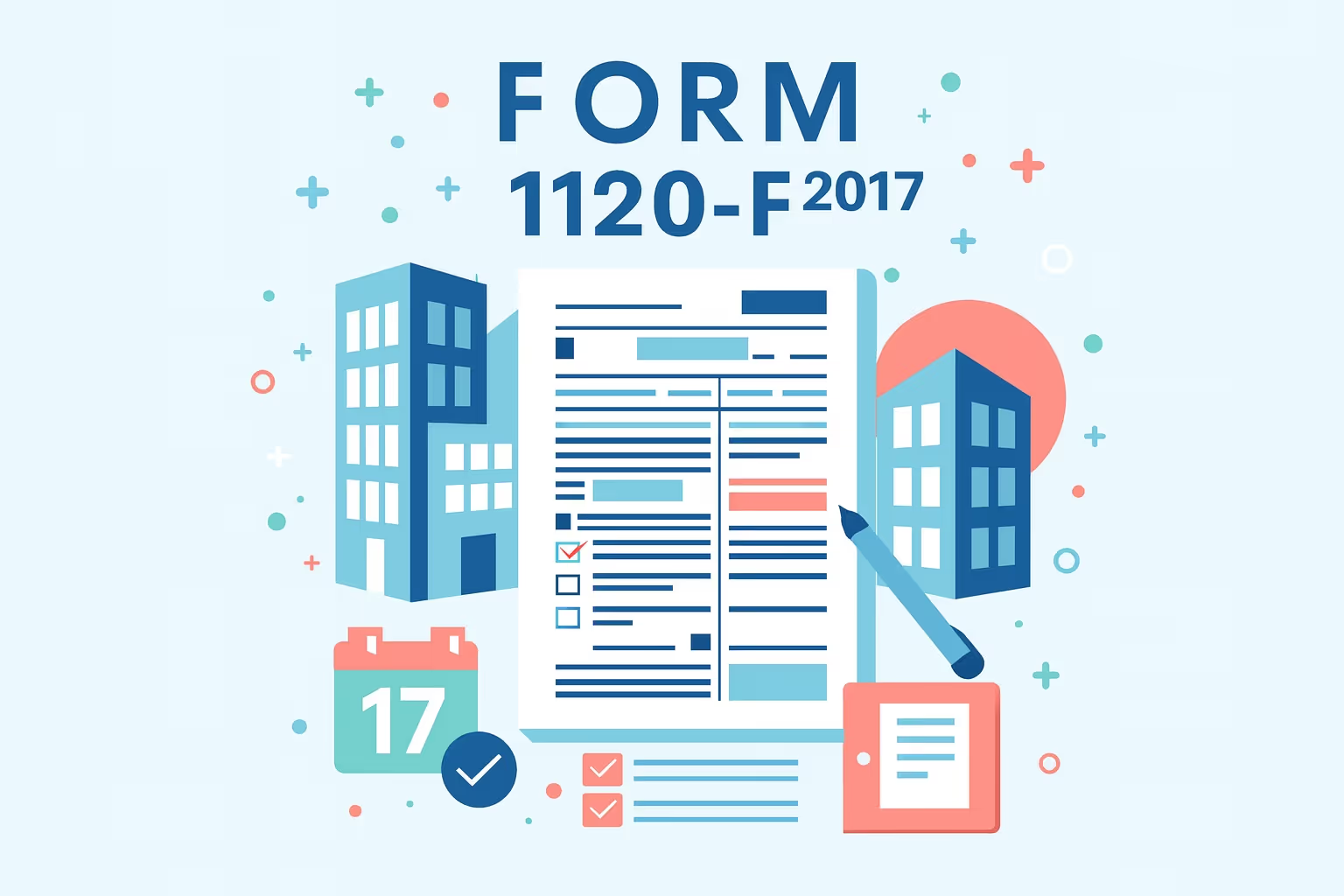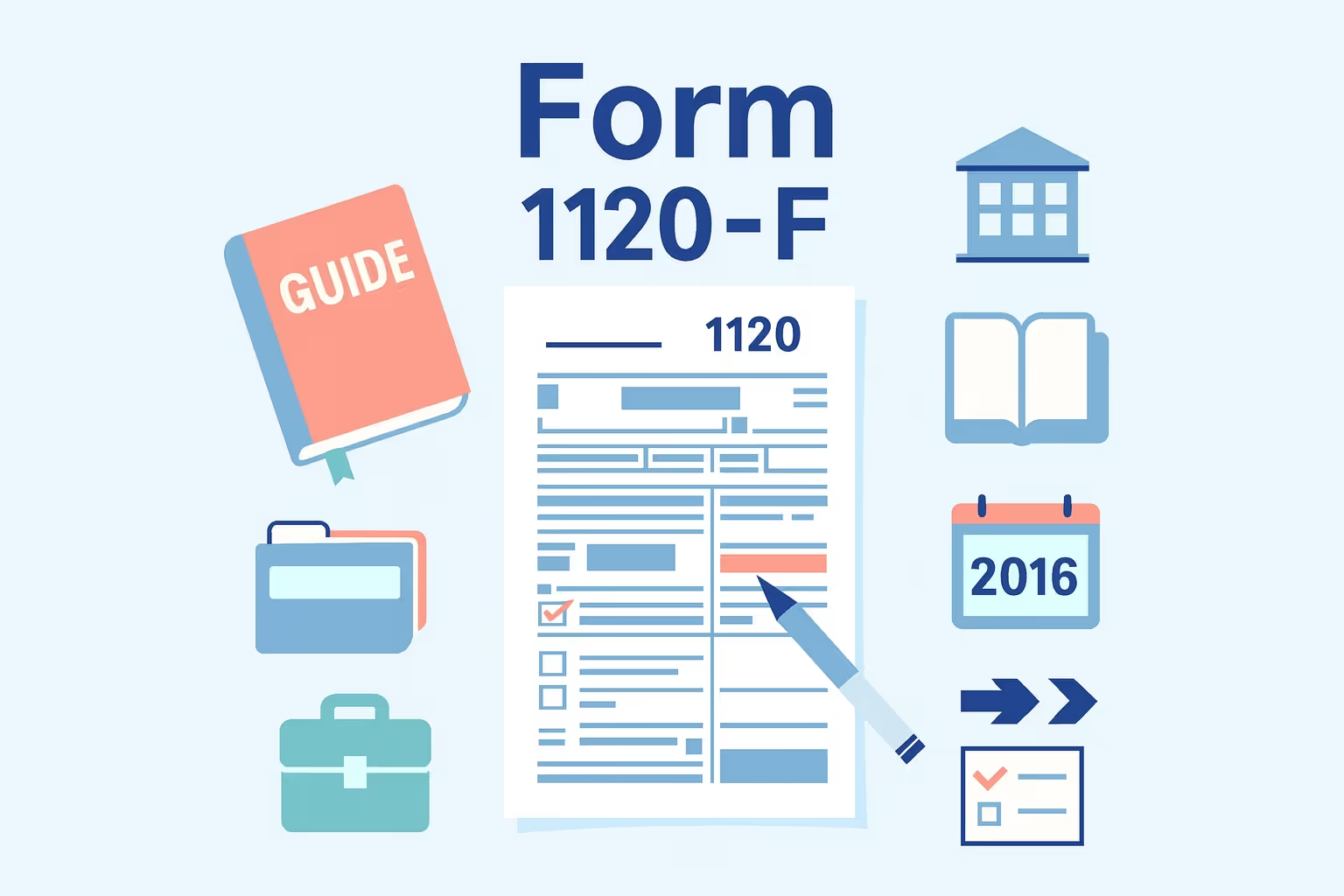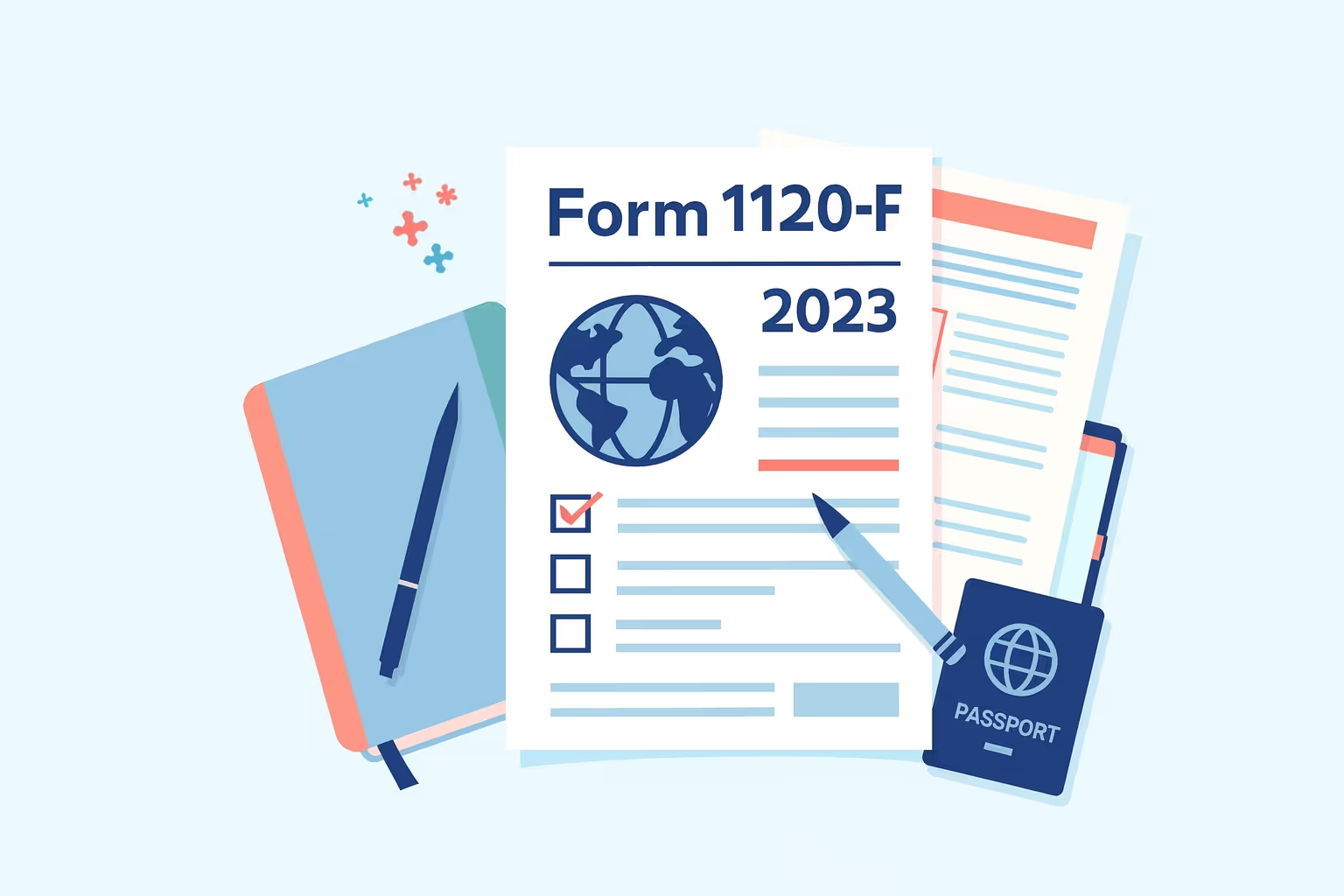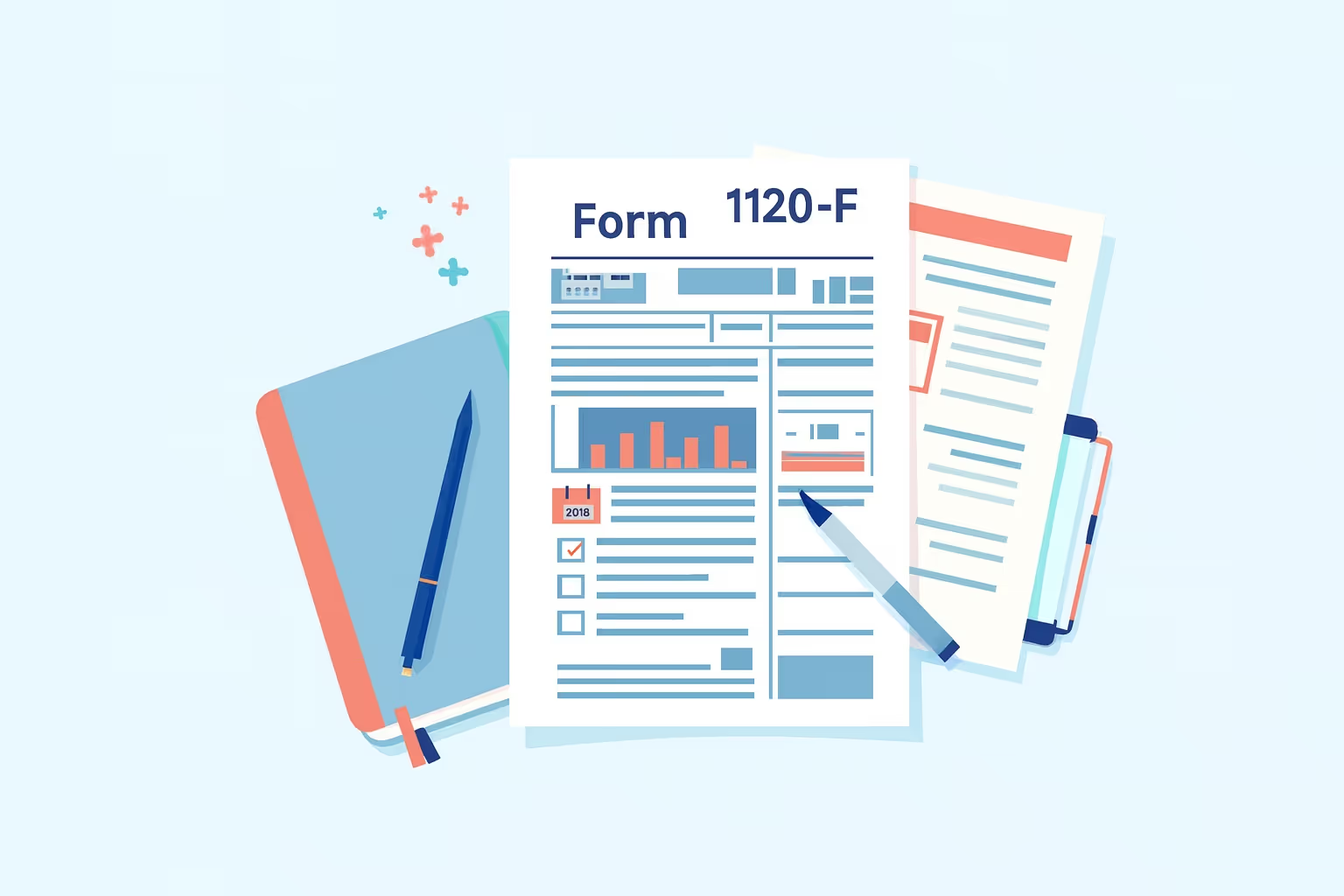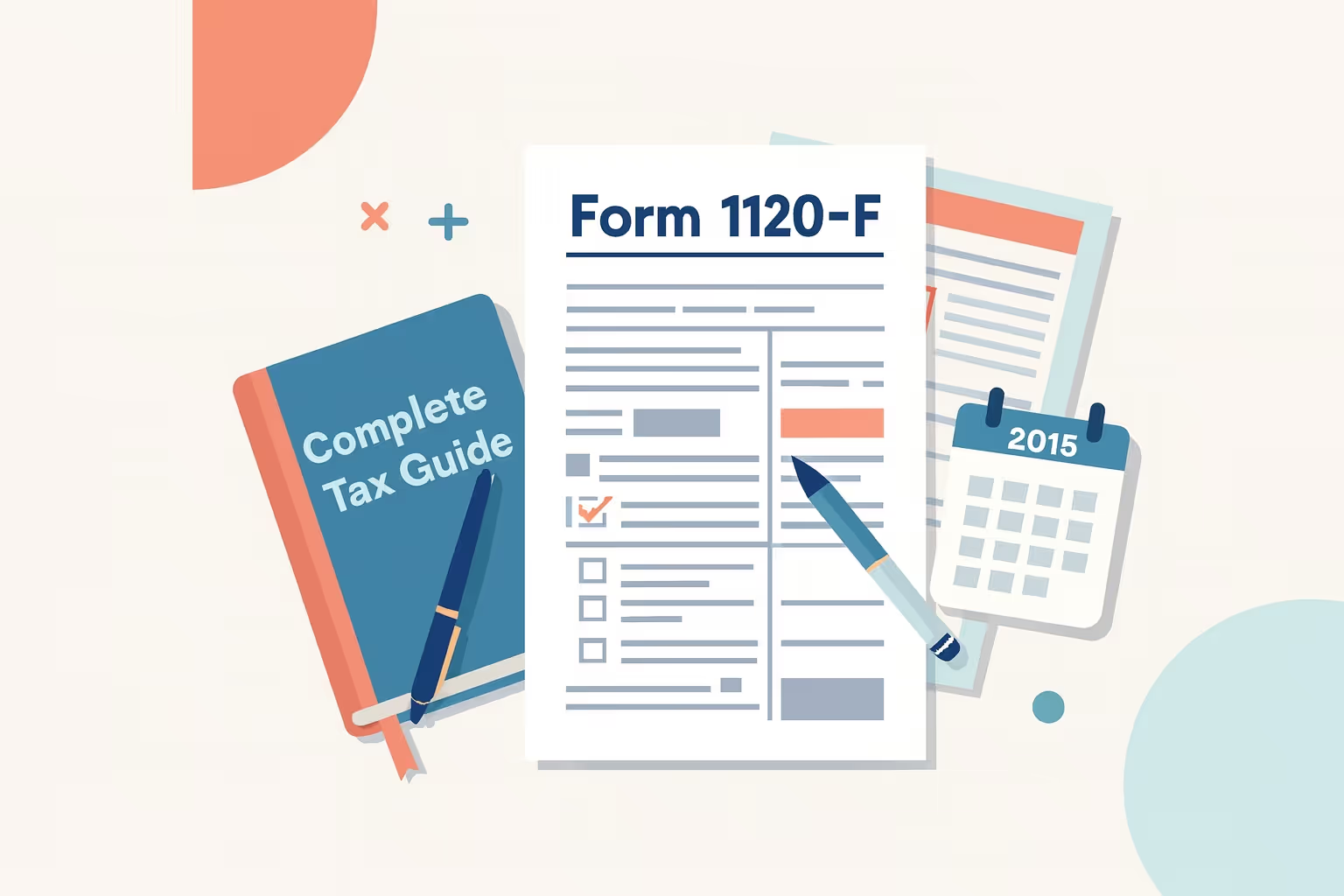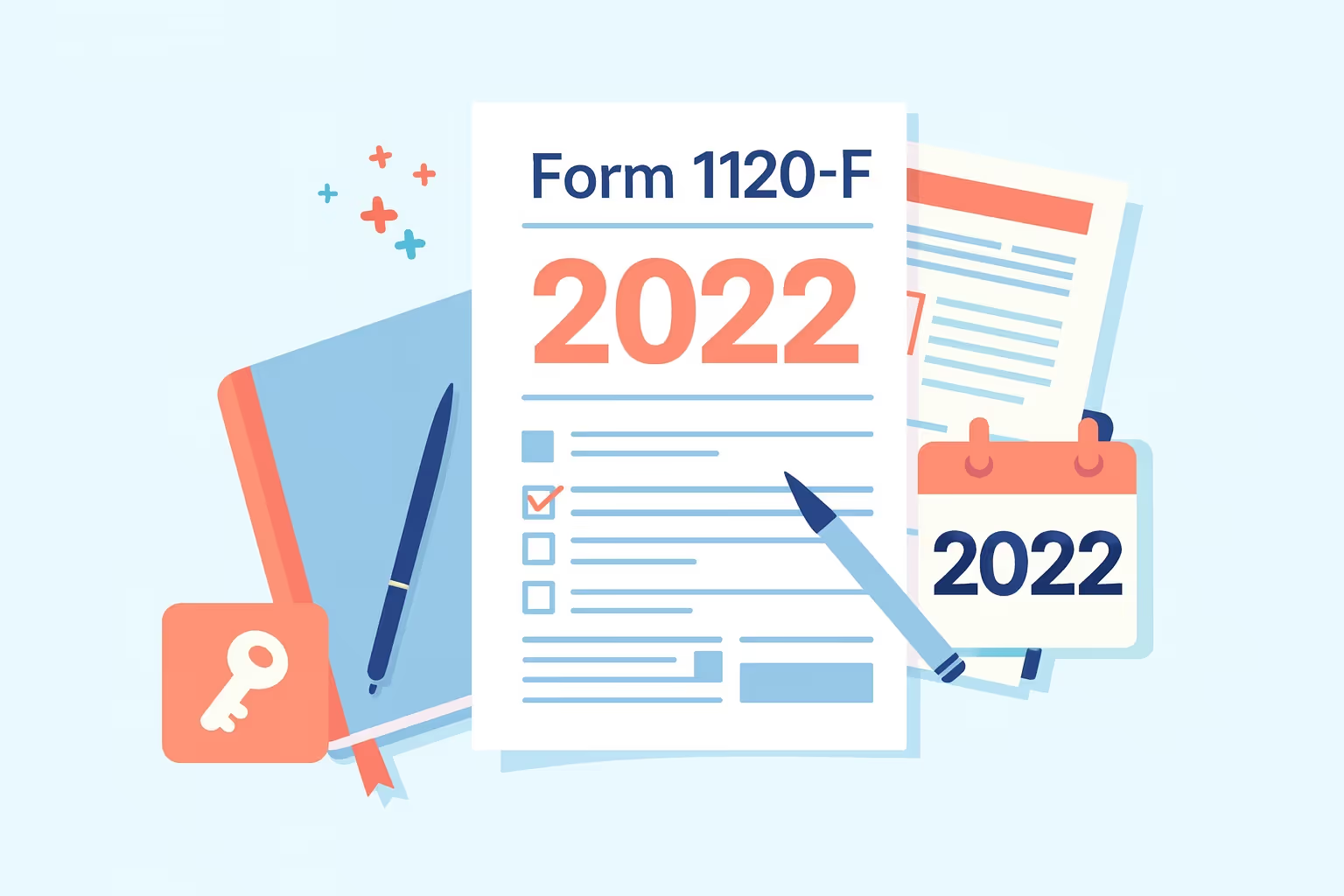Instrucciones del formulario 1120-F 2019: aspectos básicos del cumplimiento
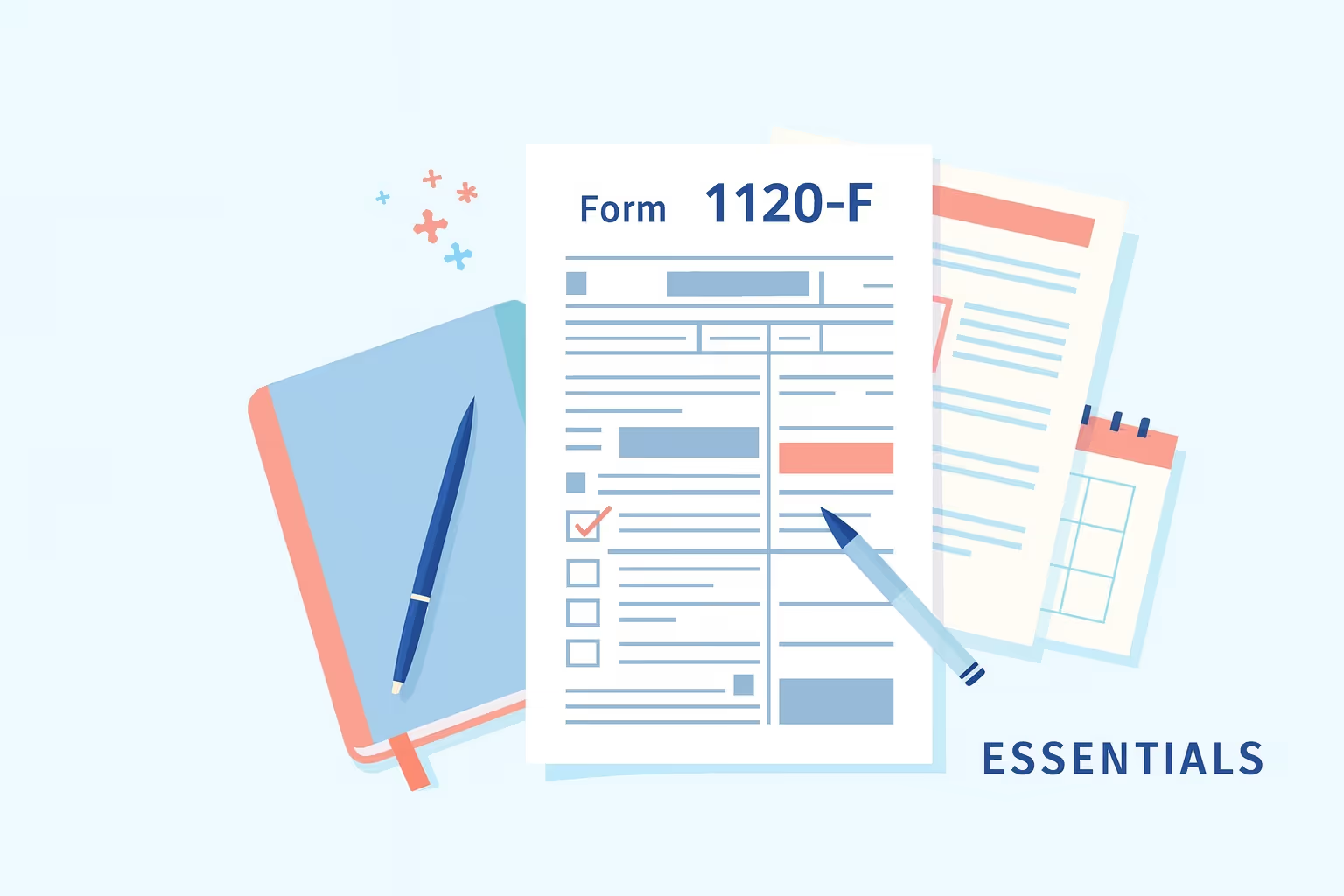
Las empresas extranjeras en los Estados Unidos deben cumplir con las normas específicas de presentación de impuestos sobre la renta. El requisito principal de presentación es la declaración del impuesto sobre la renta de las sociedades conocida como formulario 1120-F. Este formulario federal es esencial para declarar ingresos, deducciones y créditos relacionados de manera efectiva y, al mismo tiempo, garantizar que cualquier obligación tributaria sobre la renta se calcule correctamente a nivel federal.
Para el año tributario de 2019, el Código de Impuestos Internos exigía que ciertas corporaciones extranjeras declararan los ingresos imponibles de las actividades comerciales o empresariales de EE. UU. La presentación del formulario 1120-F no es opcional si la entidad tiene ingresos de origen estadounidense o si desea solicitar los beneficios de un tratado. Si no se presenta el formulario 1120-F de forma precisa o puntual, se pueden imponer multas, perder las deducciones y aumentar el riesgo total de penalización.
Esta guía proporciona instrucciones para el formulario 1120-F 2019, incluida la preparación, las reglas de fecha de vencimiento, los requisitos de presentación electrónica, las obligaciones de pago y los errores de presentación comunes que se deben evitar. Destaca la distinción entre los ingresos relacionados de manera efectiva y los ingresos del FDAP, lo que garantiza que las empresas cumplan con las normas y, al mismo tiempo, reduzcan sus obligaciones tributarias innecesarias.
Descripción general de las instrucciones del formulario 1120-F 2019
Formulario 1120-F, denominado oficialmente «Declaración de impuestos sobre la renta de los Estados Unidos de una corporación extranjera», es el formulario del IRS que utilizan las empresas con ingresos relacionados de manera efectiva con una actividad comercial o empresarial estadounidense. La declaración requiere la presentación de informes detallados de las deducciones brutas, imponibles y permitidas, según lo exigen las regulaciones. Comprender la estructura de la declaración es fundamental para el cumplimiento.
¿Quién debe presentar el formulario 1120-F?
- Participan en el comercio de EE. UU.: Las empresas deben presentar una solicitud si llevan a cabo actividades comerciales en los Estados Unidos, independientemente del monto de los ingresos.
- Ingresos conectados de manera efectiva: La presentación es obligatoria cuando una corporación ha vinculado de manera efectiva los ingresos sujetos a impuestos estadounidenses en virtud del Código de Impuestos Internos.
- Posiciones en virtud de tratados: Es necesaria una declaración cuando una corporación reclama deducciones, créditos o beneficios de un tratado, y la retención no satisface completamente la obligación tributaria.
- Reclamaciones de reembolso: Las empresas deben solicitar el reembolso de los impuestos sobre la renta pagados en exceso, incluidos los vinculados a ingresos de origen estadounidense.
Partes clave del formulario 1120-F
- Parte I: Declara los ingresos que no están relacionados de manera efectiva con una operación o negocio de EE. UU., por lo general, están sujetos a tasas fijas de retención de impuestos.
- Parte II: Cubre los ingresos conectados de manera efectiva cuando se permiten deducciones y créditos, lo que lleva al cálculo de los ingresos imponibles de las empresas.
- Parte III: Aplica las normas tributarias sobre las ganancias de las sucursales, garantizando que las empresas extranjeras paguen los impuestos adecuados sobre las ganancias consideradas repatriadas.
Obligaciones de ingresos y presentación de impuestos conectadas de manera efectiva
Los ingresos conectados de manera efectiva (ECI) representan los ingresos de actividades comerciales vinculadas a un establecimiento permanente en los Estados Unidos. Se grava a la tasa impositiva correspondiente según el Código de Impuestos Internos y exige que las empresas completen la parte II del formulario. La clasificación errónea de los ingresos como ECI o FDAP puede generar errores en la presentación de informes que reducen las deducciones y aumentan la obligación tributaria.
¿Qué se considera un ingreso conectado de manera efectiva (ECI)?
- Actividades empresariales: El ECI incluye los ingresos generados a través de una operación o negocio en EE. UU., incluidos los contratos de servicio y los ingresos operativos de las actividades activas.
- Bienes inmuebles: Los ingresos por alquiler y los ingresos por ventas de bienes inmuebles estadounidenses generalmente se consideran relacionados de manera efectiva.
- Servicios personales: La compensación por los servicios prestados en los Estados Unidos se clasifica como ECI y se grava como ingreso empresarial.
- Pruebas aplicadas: Las pruebas de uso de activos y actividades comerciales determinan si los ingresos califican como conectados de manera efectiva.
Importancia de informar correctamente
La identificación adecuada de los ingresos conectados de manera efectiva permite a una corporación calcular con precisión la obligación tributaria sobre la renta. Según el Código de Impuestos Internos, solo la ECI reúne los requisitos para recibir deducciones, créditos y deducciones especiales. Combinar productos no basados en el ECI con impuestos no incluidos en el ECI puede resultar en la denegación de deducciones, un ingreso imponible más alto y un aumento de los impuestos en la declaración de impuestos sobre la renta de la corporación.
Impacto de las posiciones de los tratados
Los tratados tributarios entre los Estados Unidos y un país extranjero pueden reducir o eximir la obligación tributaria estadounidense de ciertas empresas. Para solicitar los beneficios, las empresas deben presentar el formulario 8833 cuando sea necesario. Estos tratados suelen definir las reglas de establecimiento permanente, eximen los ingresos empresariales y reducen los impuestos sobre los ingresos (ECI) efectivamente conectados, lo que evita la doble tributación en todas las jurisdicciones.
Requisitos tributarios estimados para sociedades extranjeras
Por lo general, las empresas extranjeras con ingresos imponibles estadounidenses superiores a 500 dólares deben realizar pagos de impuestos estimados. Estas cuotas reducen la obligación tributaria impaga al final del año y evitan las multas por pago insuficiente. El impuesto estimado se aplica a las sociedades extranjeras existentes y a determinadas empresas extranjeras con nuevas operaciones comerciales en EE. UU.
Cuándo se aplica el impuesto estimado
- Umbral de ingresos: Una corporación debe realizar pagos de impuestos estimados cuando se espera que la obligación tributaria total supere los 500 dólares para el año tributario.
- Entidades aplicables: Los requisitos se aplican a las empresas que operan en los EE. UU., independientemente de si los ingresos se obtienen a través de un establecimiento permanente.
- Devolución a corto plazo: Las empresas con un año tributario corto deben ajustar su programa de impuestos estimados en consecuencia para cumplir con las normas.
Plazos para los pagos de impuestos estimados
- Primer trimestre: Para los contribuyentes del año calendario, el primer pago de impuestos estimados, que cubre la parte inicial de los ingresos imponibles del año, vence el 15 de abril.
- Segundo trimestre: El segundo pago de impuestos estimado vence el 17 de junio de 2019 y refleja las proyecciones actualizadas de ingresos comerciales o la obligación tributaria del año anterior para las empresas.
- Tercer trimestre: El tercer pago de impuestos estimados vence el 16 de septiembre y puede requerir ajustes para las deducciones, los créditos o los cálculos de ingresos revisados en función de los resultados del año hasta la fecha.
- Cuarto trimestre: El cuarto pago de impuestos estimados vence el 16 de diciembre y se ha completado el cronograma de cuotas anuales para el impuesto sobre la renta estimado adeudado por la corporación.
Sanciones por pago insuficiente
No hacer los pagos de impuestos estimados a tiempo genera responsabilidad por multas e intereses. Las empresas pueden reducir la exposición aplicando el método de puerto seguro del año anterior. El enfoque de ingresos anualizados también puede minimizar las multas cuando los ingresos varían significativamente a lo largo del año tributario.
Cómo presentar el formulario 1120-F
Las sociedades extranjeras deben presentar el formulario 1120-F ante el Servicio de Impuestos Internos antes de la fecha de vencimiento correcta. La presentación se puede realizar en papel o electrónicamente. Las grandes corporaciones con activos totales significativos deben usar sistemas de archivo electrónico, mientras que las entidades más pequeñas pueden optar por archivar en papel.
Fechas límite de presentación y reglas de fecha límite
Las empresas con una oficina en los EE. UU. deben presentar la solicitud antes del día 15 del cuarto mes siguiente al año tributario, y las corporaciones que no tengan una oficina en los EE. UU. deben presentar la solicitud antes del día 15 del sexto mes. Se puede solicitar una prórroga automática presentando el formulario 7004 antes de la fecha de vencimiento original.
Opciones para archivar electrónicamente
- Archivo electrónico obligatorio: Las empresas con activos totales superiores a 10 millones de dólares y al menos 250 declaraciones anuales deben presentar electrónicamente el formulario 1120-F.
- Archivo electrónico voluntario: Las empresas que no estén obligadas a presentar la solicitud electrónicamente pueden optar por hacerlo, lo que resulta en un procesamiento y una confirmación más rápidos.
- Software aprobado por el IRS: La presentación electrónica requiere un software aprobado por el IRS o la asistencia de emisores de declaraciones electrónicas autorizados.
Firma y mantenimiento de registros
Un oficial corporativo autorizado debe firmar la declaración. Las corporaciones deben mantener un registro de los ingresos brutos, las deducciones, los créditos y las divulgaciones de los tratados. Se requieren libros precisos para cumplir con las normas del IRS y respaldar los montos declarados. La falta de mantenimiento de los registros puede generar una exposición fiscal adicional.
Pagos electrónicos y liquidación de obligaciones tributarias
Las corporaciones deben liquidar sus obligaciones tributarias sobre la renta antes de la fecha de vencimiento de la declaración. El IRS recomienda los pagos electrónicos, que garantizan la transferencia segura de fondos, reducen las demoras y proporcionan confirmación. El uso de métodos electrónicos también apoya el cumplimiento de los contribuyentes y evita la acumulación de impuestos impagos.
Métodos de pago electrónico
- Sistema electrónico de pago de impuestos federales (EFTPS): Esta es una plataforma segura para que las empresas paguen sus obligaciones tributarias en línea, accesible en todo el mundo.
- Retiro electrónico de fondos: El retiro electrónico está disponible cuando las empresas presentan electrónicamente la declaración de impuestos sobre la renta, lo que permite la programación automática de los pagos.
- Tarjeta de crédito o débito: Los pagos se pueden realizar a través de procesadores aprobados por el IRS y se aplican tarifas de servicio por cada transacción.
Pago atrasado y multas
Los pagos atrasados generan cargos por intereses y una multa por presentación tardía. Los impuestos impagos aumentan la exposición total a las multas. Los pagos electrónicos puntuales evitan costos adicionales y ayudan a las empresas a cumplir con los requisitos del IRS.
Nota de cumplimiento
Se recomienda encarecidamente a todas las empresas los pagos electrónicos. Reducen la carga administrativa, aseguran el procesamiento a nivel federal y demuestran el cumplimiento puntual de las regulaciones tributarias de los EE. UU.
Sección II: Ingresos y deducciones conectados de manera efectiva
La sección II es la sección principal del formulario 1120-F. Declara los ingresos relacionados de manera efectiva con el comercio de EE. UU. con las deducciones permitidas por el Código de Impuestos Internos y calcula los ingresos imponibles. En este caso, la clasificación adecuada garantiza que la obligación tributaria sobre la renta sea correcta y evita que se exagere el impuesto que aparece en la declaración.
Líneas de ingresos 1—11
- Ingresos brutos: Las empresas declaran las ventas o los servicios en EE. UU., restando las devoluciones y bonificaciones, para calcular los ingresos brutos de las actividades comerciales.
- Costo de los bienes vendidos: Utilice el formulario 1125-A para detallar el inventario de las propiedades compradas y vendidas, garantizando la precisión de los informes de asignación de costos.
- Otros ingresos: Indique los dividendos, intereses, alquileres, ganancias de capital o ingresos de EE. UU. vinculados a las fuentes de ingresos de la subparte F, si corresponde.
Líneas de deducciones 12 a 30
- Gastos comerciales ordinarios: Las empresas reclaman deducciones por salarios, alquileres, reparaciones y otros costos incurridos mientras obtienen ingresos conectados de manera efectiva.
- Asignación de intereses: Indique los gastos por intereses en el Anexo I, aplicando la sección 1.882-5 del reglamento para asignarlos adecuadamente entre las actividades de la ECI y las que no son de la ECI.
- Deducciones especiales: Las empresas pueden solicitar contribuciones caritativas, pérdidas operativas netas u otras deducciones permitidas para reducir los ingresos imponibles.
Cálculo de ingresos imponibles
El ingreso total menos las deducciones permitidas produce ingresos imponibles. La sección II alinea los resultados corporativos con los estándares corporativos nacionales, aplicando la tasa impositiva apropiada para calcular la responsabilidad.
Anexo J: Cálculo de impuestos
El Anexo J calcula la obligación tributaria federal de la corporación. Consolida los ingresos imponibles, los créditos y los impuestos especiales para determinar el impuesto final que se muestra en la declaración.
Impuestos y créditos regulares
- Tasa de impuesto corporativo: La tasa fija del 21 por ciento se aplica a los ingresos conectados de manera más efectiva, de acuerdo con las normas tributarias federales.
- Créditos disponibles: Las empresas extranjeras pueden solicitar créditos, como créditos fiscales extranjeros o comerciales generales, para reducir la responsabilidad.
- Impuesto base a la erosión: Ciertas empresas con grandes pagos a partes relacionadas deben calcular el impuesto mínimo de erosión de la base además del impuesto sobre la renta corporativo regular.
Conciliación de totales
Los totales del Anexo J van a la página 1, línea 2 del formulario 1120-F. Las empresas deben asegurarse de que todas las partes se concilien con precisión para evitar discrepancias y consultas del IRS.
Sección III: Impuesto sobre las ganancias de las sucursales e intereses excedentes
La sección III aplica un nivel adicional de impuestos a las sociedades extranjeras que operan a través de sucursales en los Estados Unidos. Garantiza la paridad con las empresas nacionales que distribuyen dividendos a los accionistas.
Importe equivalente de dividendos
- Punto de partida: Utilice los ingresos imponibles de la Sección II, línea 29, y luego ajústelos para tener en cuenta las ganancias y ganancias relacionadas de manera efectiva.
- Ajustes de capital: Las empresas calculan los cambios netos en las acciones de EE. UU. para determinar las ganancias reinvertidas frente a las repatriadas.
- Impuesto sobre las ganancias de las sucursales: A menos que esté exento en virtud de las disposiciones del tratado, se aplica una tasa del tratado del 30 por ciento o menos al monto equivalente al dividendo.
Impuesto sobre intereses excesivos
El exceso de interés se aplica cuando las deducciones de intereses superan los pasivos relacionados con EE. UU. Las empresas deben calcular y declarar este pasivo para garantizar el cumplimiento de las normas de la sección 884 del Código de Impuestos Internos.
Horarios requeridos y archivos adjuntos clave
El formulario 1120-F requiere varios anexos y anexos para documentar correctamente las deducciones, las asignaciones de intereses y las reclamaciones en virtud de tratados. Los cronogramas faltantes o incompletos a menudo provocan la correspondencia del IRS.
Horarios obligatorios
- Programa H: Este cronograma asigna las deducciones entre los ingresos conectados de manera efectiva y los no conectados de manera efectiva, como lo exige la sección 1.861-8 del reglamento.
- Programa I: Este cronograma detalla la asignación de gastos por intereses y proporciona la base para las deducciones según las reglas de la sección 1.882-5.
- Programa M-1 o M-3: Este cronograma concilia los ingresos contables con los ingresos imponibles. Las empresas con activos totales superiores a 10 millones de dólares deben presentar el Anexo M-3.
Programaciones condicionales
- Programa P: Este cronograma informa los ingresos de las sociedades clasificados como conectados de manera efectiva, según las asignaciones de K-1.
- Programa Q: Este anexo es obligatorio para las sucursales que actúan como agentes de derivados calificados, y revela los pasivos relacionados con los derivados.
- Programa S o V: Este cronograma informa los ingresos por envío, aeronave o transporte bruto que reúnen los requisitos para las exenciones de la Sección 883.
Otros formularios del IRS
- Formulario 5472: Este formulario informa sobre las transacciones de partes relacionadas con filiales nacionales o extranjeras.
- Formulario 8833: Este formulario es obligatorio cuando las posiciones de los tratados anulan o modifican las disposiciones del Código de Impuestos Internos.
- Formulario 8832: Este formulario se presenta cuando una LLC clasificada para las elecciones federales elige un estado tributario diferente.
Métodos de presentación y firmas
El formulario 1120-F se puede presentar en papel o electrónicamente. Se recomienda encarecidamente la presentación electrónica, especialmente para las empresas con grandes activos totales o necesidades de presentación complejas.
Requisitos de presentación electrónica
- Uso obligatorio: Las empresas con 10 millones de dólares en activos y 250 o más declaraciones al año deben presentar su declaración electrónicamente.
- Uso voluntario: Las empresas más pequeñas pueden presentar sus solicitudes electrónicamente de forma voluntaria, lo que se beneficia de una confirmación más rápida y de menos errores.
- Formularios de autorización: Las empresas deben incluir el formulario 8879-I para la autorización de firma electrónica cuando utilizan un proveedor aprobado por el IRS.
Archivado en papel
Las empresas más pequeñas pueden seguir presentando documentos. Las declaraciones deben enviarse por correo al Centro de Servicio del IRS en Ogden, Utah. Se pueden usar servicios de entrega privados, pero deben cumplir con los estándares del IRS.
Firmas autorizadas
Solo un funcionario corporativo puede firmar la declaración. Si un preparador completa la presentación, también se deben revelar los detalles y la identificación del preparador.
Pagos y obligaciones tributarias estimadas
La obligación tributaria calculada en la declaración debe pagarse antes de la fecha de vencimiento; la falta de pago a tiempo resulta en una multa e intereses por presentación tardía. Se alienta a las empresas a utilizar los pagos electrónicos para mayor precisión y rapidez.
Métodos de pago
- PASOS: El Sistema Electrónico de Pago de Impuestos Federales sigue siendo el método principal para los contribuyentes corporativos.
- Retiro electrónico de fondos: El retiro electrónico solo está disponible cuando las declaraciones se presentan electrónicamente, lo que permite la presentación y el pago simultáneos.
- Pagos con tarjeta: Las empresas pueden pagar a través de procesadores autorizados por el IRS con tarjetas de crédito o débito.
Liquidaciones fiscales estimadas
Las obligaciones tributarias estimadas trimestrales deben pagarse con prontitud para evitar multas por pago insuficiente. Las empresas pueden basarse en las normas de puerto seguro del año anterior o en los métodos de ingresos anualizados para cumplir con estos requisitos.
Cumplimiento y sanciones
Los pagos atrasados de impuestos generan intereses y multas. La multa total incluye la falta de presentación y la falta de pago de las cuotas, calculadas según las disposiciones del Código de Impuestos Internos.
Retornos de protección y años sin actividad
Incluso las empresas sin ingresos deben considerar la posibilidad de presentar una declaración de protección. La presentación conserva las deducciones, los créditos y los beneficios derivados de los tratados si el IRS determina más adelante que existen ingresos efectivamente relacionados.
Cuándo presentar una declaración de protección
- Actividad limitada: Una corporación extranjera debe presentar la solicitud si tiene un mínimo de actividades comerciales en EE. UU. que puedan considerarse efectivamente relacionadas más adelante.
- Retener la exposición: La presentación es obligatoria si los ingresos de origen estadounidense estuvieron sujetos a retención, pero las deducciones o los beneficios del tratado se pueden solicitar más adelante.
- Protección del tratado: Una declaración cautelar protege los derechos cuando las empresas tienen la intención de basarse en las disposiciones de los tratados tributarios para obtener la exención o la reducción de la responsabilidad.
Reglas de presentación durante un año de inactividad
Las empresas sin ingresos comerciales en EE. UU. pueden presentar una declaración simplificada. Una declaración a corto plazo mantiene el cumplimiento y evita futuras disputas.
Posiciones en virtud de tratados y divulgaciones requeridas
Muchas empresas confían en los beneficios de los tratados tributarios para reducir su responsabilidad. Estas disposiciones pueden eximir los ingresos de las empresas, reducir el impuesto sobre las ganancias de las sucursales o evitar la doble tributación entre los Estados Unidos y un país extranjero.
Reclamar los beneficios del tratado
- Requisitos de residencia: Las empresas deben demostrar que son residentes fiscales de un país con tratado para acceder a tasas impositivas sobre la renta reducidas de EE. UU.
- Limitación de beneficios: Los tratados suelen exigir que las empresas cumplan con las pruebas de propiedad o actividad antes de que los beneficios se apliquen a los ingresos conectados de manera efectiva.
- Obligaciones de documentación: Las empresas deben presentar el formulario W-8BEN-E y, posiblemente, un certificado de residencia de la autoridad tributaria extranjera para solicitar la protección de un tratado.
Cuándo se requiere el formulario 8833
- Disposiciones de anulación: Una corporación debe presentar el formulario 8833 cuando una posición en un tratado anula o modifica las normas del Código de Impuestos Internos que afectan la renta imponible.
- Riesgo de penalización: No presentar el formulario 8833 cuando es necesario puede resultar en una multa de 10 000 dólares por puesto basado en un tratado.
- Exenciones: Es posible que las solicitudes rutinarias de retención reducida no requieran el formulario 8833, pero las empresas deben confirmar los requisitos en las instrucciones.
Mantenimiento de registros y preparación para auditorías
Es esencial mantener registros adecuados. Las empresas deben llevar libros en inglés, conservar los cronogramas justificativos y traducir los documentos extranjeros cuando se les solicite. Una documentación deficiente conduce a ajustes, a una mayor obligación tributaria y a la denegación de deducciones.
Registros requeridos
- Libros de contabilidad: Las empresas deben mantener registros de los ingresos brutos, las deducciones, los créditos y los cronogramas que respalden los ingresos conectados de manera efectiva.
- Traducción al inglés: El IRS exige traducciones certificadas de registros en idiomas extranjeros si se utilizan para corroborar los montos declarados.
- Periodo de retención: Los registros deben conservarse durante todo el plazo de prescripción, generalmente tres años o más para cuestiones específicas.
Preparación de la auditoría
Las empresas deben conciliar los cronogramas con la declaración, garantizar la precisión matemática y mantener informes consistentes. La documentación adecuada reduce el riesgo de ajustes y protege los puestos de los tratados durante los exámenes.
Errores de presentación comunes y cómo evitarlos
Los errores aumentan el riesgo de multas, deducciones perdidas y exámenes prolongados del IRS. Revisar los errores frecuentes ayuda a las empresas a proteger el cumplimiento y a evitar una exposición tributaria innecesaria.
Errores frecuentes
- Plazos incumplidos: Las empresas que presentan el formulario 1120-F con retraso pierden sus deducciones y se enfrentan a importantes multas por presentación por parte del IRS.
- Clasificación incorrecta: La clasificación errónea de los ingresos del FDAP como ingresos efectivamente conectados da como resultado la denegación de deducciones y una obligación tributaria sobre la renta exagerada.
- Horarios omitidos: Si no se incluye el Anexo H, el Anexo I o el Formulario 5472, el IRS rechaza o cuestiona la declaración.
- Errores matemáticos: Los cálculos de los ingresos imponibles o los errores de conciliación del Anexo J crean totales inconsistentes en diferentes partes de la declaración del impuesto sobre la renta de sociedades.
Consejos para quienes declaran por primera vez
Los nuevos declarantes se enfrentan a curvas de aprendizaje empinadas. El establecimiento temprano de hábitos de cumplimiento garantiza la precisión de las presentaciones y evita la exposición a sanciones innecesarias. Las empresas deben priorizar la organización, la planificación y la asistencia profesional cuando sea necesario.
Consejos para el éxito
- Obtenga un EIN: Una corporación extranjera debe tener un número de identificación del empleador antes de presentar el formulario 1120-F o realizar pagos de impuestos estimados.
- Comience temprano: Preparar la declaración por adelantado garantiza tiempo para reunir los documentos de respaldo y verificar que los ingresos brutos y las deducciones sean correctos.
- Contrata a expertos: El uso de profesionales familiarizados con el derecho tributario internacional reduce los errores, respalda las reclamaciones de los tratados y garantiza el cumplimiento de los requisitos del Código de Impuestos Internos.
- Usa listas de verificación: La preparación de las listas de verificación para la presentación garantiza que los cronogramas, los archivos adjuntos y los pagos electrónicos estén completos antes de presentar la declaración del impuesto sobre la renta de las sociedades.
Después de presentar la solicitud: avisos, reembolsos y enmiendas
El IRS puede emitir avisos después de la presentación. Las empresas deben estar preparadas para responder con prontitud, hacer un seguimiento de las solicitudes de reembolso o corregir los errores descubiertos después de la presentación.
Asuntos posteriores a la presentación
- Avisos del IRS: Las empresas suelen recibir correspondencia solicitando aclaraciones sobre los montos declarados o cronogramas justificativos vinculados a los ingresos conectados de manera efectiva.
- Reclamaciones de reembolso: La retención en origen pagada en exceso puede reembolsarse si el formulario 1120-F incluye documentación precisa, como los formularios 1042-S.
- Modificaciones: Los errores descubiertos después de la presentación requieren declaraciones modificadas. Las empresas deben presentar la solicitud con prontitud para corregir los problemas y preservar las deducciones.
Glosario de términos clave
La comprensión de los términos técnicos garantiza que las empresas puedan interpretar las instrucciones correctamente. El glosario destaca los conceptos recurrentes en el proceso de presentación.
Términos clave
- Ingresos conectados de manera efectiva (ECI): Los ingresos de una actividad comercial o empresarial en EE. UU. se gravan según las tasas corporativas, y la corporación puede solicitar las deducciones y los créditos correspondientes sobre los ingresos efectivamente relacionados.
- Ingresos del FDAP: Los ingresos fijos, determinables, anuales o periódicos de origen estadounidense no están relacionados con una actividad comercial o empresarial y, por lo general, están sujetos a una retención fiscal fija.
- Establecimiento permanente: Un establecimiento fijo de negocios en los Estados Unidos constituye un establecimiento permanente y puede dar lugar a la tributación, en virtud de un tratado, de las ganancias empresariales declaradas en el formulario 1120-F.
- Impuesto sobre las ganancias de las sucursales: Los Estados Unidos imponen un impuesto del treinta por ciento sobre las ganancias de las sucursales sobre los montos equivalentes a dividendos, aunque un tratado tributario puede reducir la tasa para los residentes que reúnan los requisitos.
- Impuesto estimado: Las empresas deben realizar pagos estimados trimestrales cuando se espera que el impuesto federal para el año sea de quinientos dólares o más, lo que limita los cargos por intereses y las multas por pago insuficiente.
Preguntas frecuentes
¿Debo presentar el formulario 1120-F si mi corporación no tenía ingresos en EE. UU.?
Si su empresa no tenía ingresos de origen estadounidense ni operaciones comerciales en EE. UU., es posible que no se requiera el formulario 1120-F. Sin embargo, la presentación de una declaración cautelar preserva las deducciones, los créditos y los beneficios del tratado si el IRS determina más adelante que existían ingresos relacionados de manera efectiva. Este enfoque ayuda a evitar multas y protege los derechos de presentación futuros.
¿Cómo puedo determinar si los ingresos son ingresos conectados de manera efectiva?
Los ingresos están conectados de manera efectiva si provienen de activos utilizados o actividades de una operación o negocio estadounidense. Las pruebas de uso de activos y actividades empresariales que establece el Código de Impuestos Internos ayudan a confirmar la clasificación. Una determinación correcta garantiza que las deducciones se apliquen correctamente y evita que se declaren erróneamente los ingresos imponibles o que los ingresos del FDAP queden exentos de la declaración.
¿Cuándo se requiere el formulario 8833 para las reclamaciones en virtud de tratados?
Se requiere el formulario 8833 cuando una corporación reclama beneficios de tratados que anulan o modifican las reglas del Código de Impuestos Internos. Esto incluye situaciones en las que las exenciones de los tratados reducen de manera efectiva los impuestos sobre la renta conexos. No presentar el formulario 8833 cuando sea necesario puede conllevar sanciones. La reducción rutinaria de la retención en virtud de un tratado no suele requerir este formulario, pero la confirmación es esencial.
¿Cómo se calcula el impuesto sobre las ganancias de las sucursales para las empresas extranjeras?
El impuesto sobre las ganancias de las sucursales generalmente se calcula como el 30 por ciento de las ganancias y ganancias efectivamente relacionadas que se consideran repatriadas. Las empresas reducen su responsabilidad aumentando el capital neto de EE. UU. o aplicando medidas cautelares en virtud de tratados. Se requiere documentación, incluidos los estados de patrimonio neto de inicio y fin de año, para respaldar los ajustes. Los cálculos incorrectos aumentan la exposición total a las multas y pueden provocar un escrutinio adicional del IRS.
¿Cuáles son los plazos de impuestos estimados para quienes presenten el formulario 1120-F?
Las empresas que esperan más de 500 dólares en obligaciones tributarias deben pagar cuotas trimestrales. Para 2019, los plazos vencían el 15 de abril, el 17 de junio, el 16 de septiembre y el 16 de diciembre. Las devoluciones a corto plazo deben ajustar estas fechas. El incumplimiento de los plazos de pago conlleva la responsabilidad de pagar multas e intereses, pero las empresas pueden utilizar las normas de puerto seguro para minimizar los costos adicionales.
¿Qué registros se deben mantener para las deducciones y la asignación de intereses?
Las empresas deben mantener libros y registros que respalden las deducciones, los créditos y las asignaciones, incluidas las traducciones al inglés cuando sea necesario. Los anexos H e I documentan las asignaciones de deducciones e intereses. La falta de mantenimiento de los registros crea el riesgo de que se anulen las deducciones, se impongan impuestos adicionales y se impongan multas. Mantener la documentación precisa y completa es esencial para la preparación de la auditoría y el cumplimiento a largo plazo de las normas del IRS.
















